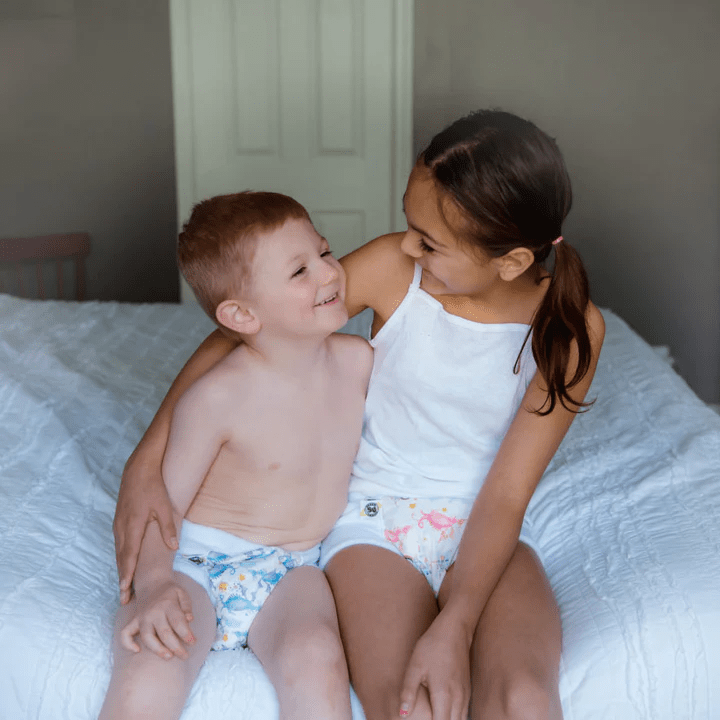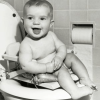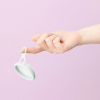Although children are day-toilet-trained around 37 months on average, night-training often takes a little longer. In many children, nighttime toilet training occurs somewhere between the ages of 3 and 5, usually a few months after achieving daytime toilet training. However, it also regularly happens that children need a little longer to stay dry at night. Around the age of 5, 15-20% of children are not yet night toilet trained. 10% of 7-year-olds are not yet toilet trained at night. Bedwetting occurs 1.5 times more often in boys than in girls. Problems with bedwetting occur in 0.5% to 2% of the population even into adulthood.
The hormone vasopressin plays a major role in night toiletries. This hormone inhibits urine production in the kidneys and is released at night to limit urine production at night. The release of this hormone in the right day-night rhythm is something that has to develop, in boys this often develops a little more slowly than in girls. In children who continue to wet the bed for a long time, there is often a disturbance in the production and release of vasopressin. There is a large degree of heredity involved in children who continue to wet the bed for a long time. Research shows that bedwetting is hereditary in 2/3 of the cases. In 1/3 of the cases it is a form in which heredity plays no role.

Potty training your child at night
You already think that there is no such thing as 'potty training' your child at night. Night toilet trained usually come naturally and can hardly be trained. Your child really has to be ready for it, not only mentally, but also physically. When your child is ready, there are several ways to support him/her through the process.
How do you know if your child is ready?
You can wait for the first dry diapers. If a child has a dry diaper several nights a week, you know that the child is able to retain urine until the morning. However, it is not absolutely necessary to wait for this. You can also wait for the moment when your child indicates that he or she would like to sleep without a diaper, or would like to take the diaper off very quickly in the morning, for example. You can also have a conversation with your child; would you like to try sleeping without a diaper? Waiting for dry diapers is not absolutely necessary. Even if a child does not (yet) have dry diapers, you can practice taking the diaper off. Some children have linked the diaper to peeing in the diaper and will therefore pee with a diaper on, while without a diaper they (unconsciously) make an effort to hold the urine.
Necessities for night toilet training
-A child who is ready
-Potty (or a toilet nearby)
-Cloth wipes near the potty
-Mattress protector and/or a large changing mat (A large changing mat such as the one from Seedling Baby is ideal to place on top of the bedding, also useful during holidays!)
-Extra bedding
-Loose-fitting clothing that can be easily put on and taken off
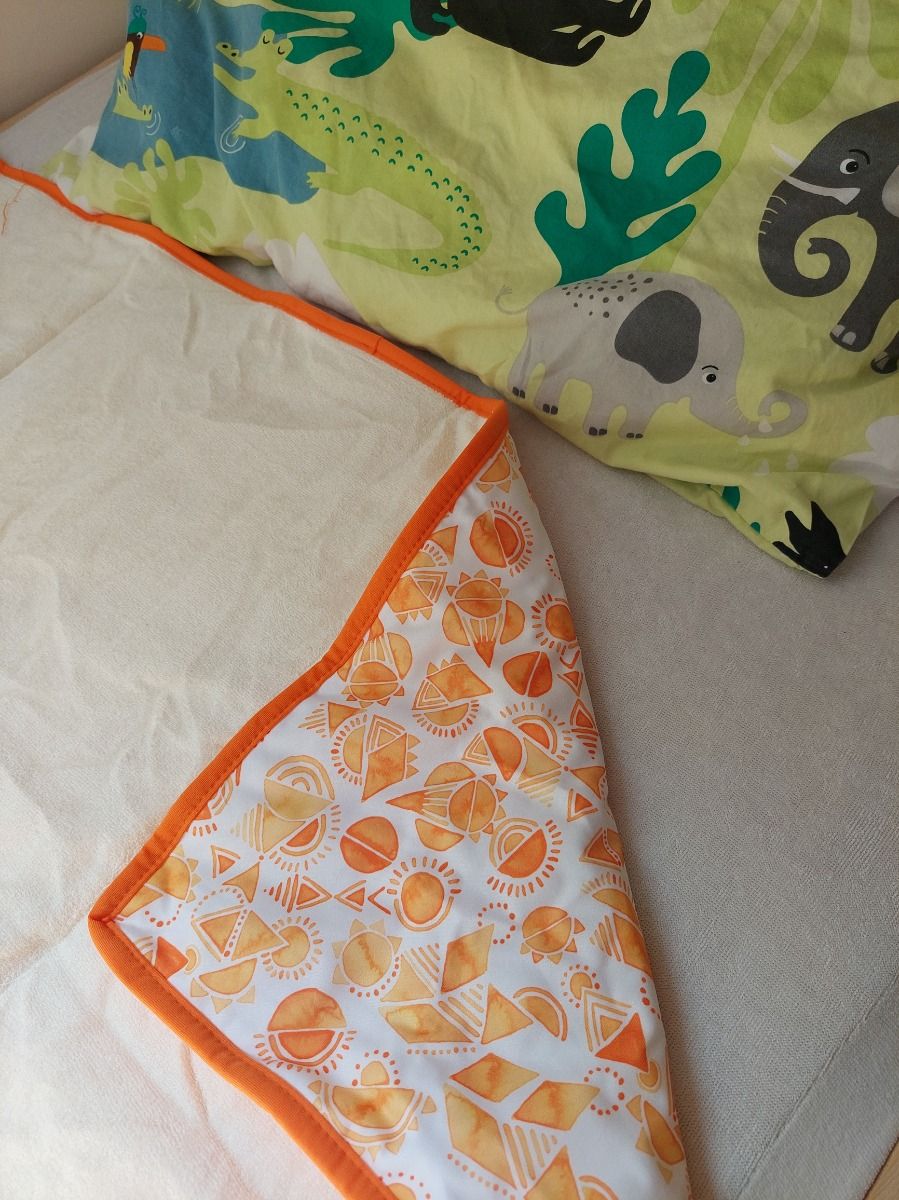
A changing mat from Seedling Baby, with an absorbent bamboo layer and a waterproof PUL layer.
Any extra’s
- Well-fitting training pants, so that only the training pants need to be changed and not the entire bed. Make sure that a child can put the pants on and off themselves and that they are sufficiently absorbed in the event of an accident.
- A calendar with stickers, to introduce a reward system. Only recommended if potty training is difficult and a child is a bit older.
Step-by-step plan for night toilet training
If your child is ready, you can follow the step-by-step plan below. As with everything in life, there is no set method that works for everyone. Opinions differ about allowing a child to urinate at night, sleeping or not. And is there any point in rewarding if the child cannot actually do anything about whether or not he or she is dry at night?
See what works for you and your child, what feels good and what doesn't. How important is the success of the dry bed and what are you willing to do for it? Are you going to stop giving a child a full glass of something to drink in the evening, or is that going too far?
Every child is different, we also noticed that things that worked well for one child were completely pointless for the other child. With three children we did the (half-asleep) evening pee for a while, with success. Forgetting or skipping a pee often resulted in a wet bed. But for one of the four children it made no sense. The peeing may or may not have been successful, but regardless of that, several pees still ended up in the bed. During the first weeks we tried to ensure that no large cups of fluid were swallowed when going to bed. However, breastfeeding was given at bedtime and when there was clear thirst or a request for a drink, we always simply gave a drink.
A possible step-by-step plan
- Choose a good moment, during a quiet period. Do not start if a child is not fit, if there are major changes in the family (on the horizon), if a child has constipation or if a child does not want to.
- Discuss the topic with your child and ask if he/she would like to sleep without a diaper.
- Make sure you have a good mattress protector in the bed, a large changing mat often works well.
- To increase the chance of success, you can limit fluid intake just before going to bed. This is of course not necessary, but in the beginning it can sometimes be the difference between success or no success.
- When putting your child to bed, tell him/her that you will let him/her urinate again when you go to bed yourself, if you plan to do so.
- Let your child urinate when you go to bed yourself, without actually waking the child. Keep it dark, calmly put your child on the potty, wait for a puddle and put the child back in. Do this at the earliest two hours after a child has fallen asleep, but it is better not to wait longer than three hours. You can also decide not to wake a child. Then don't tell your child that you will wake him/her up. Opinions are divided about whether or not to urinate (while sleeping). So do what feels good for you and your child and see what works.
- If your child is already wet during the evening pee, go to your child fifteen minutes earlier the following evening to let him/her pee. Still wet? The next day, go fifteen minutes earlier. Do not go earlier than 1.5 hours after falling asleep. If, despite this evening pee, your child continues to wet the bed later in the night, consciously wake your child up for the evening pee. Turn on the light, say his/her name and indicate that you will wake him/her up to go pee and walk to the potty or toilet together.
- If your child is dry in the morning, give a compliment. Not dry? Don't worry about it, tonight is another night! If your child likes to help change the bed, you can do that together. But do not punish the child in any way.
- If your child stays dry for a few nights in this way, you can skip the evening pee for a while. Completely dry in the morning, then the evening pee can be left out. If it is still wet, let your child urinate again in the evening.
It is very normal for a child to occasionally wet the bed at night. Continue to encourage your child, do not get angry and, if necessary, continue to get your child out of bed in the evening. This is often no longer necessary after 2 months, but if it is, you can continue with it longer. Bedwetting almost always goes away on its own.
If evening urination does not help enough to stay dry for the rest of the night, you can try other methods at some point. Consider a reward system (for example with stickers that you stick on a calendar, so you can immediately see whether bedwetting is decreasing) or a bedwetting alarm. A bedwetting alarm is especially suitable for older children. This emits a signal when the underpants/bed starts to get wet. Your child must then wake up and finish urinating in the toilet. You will probably have to help your child with this during the first few days.
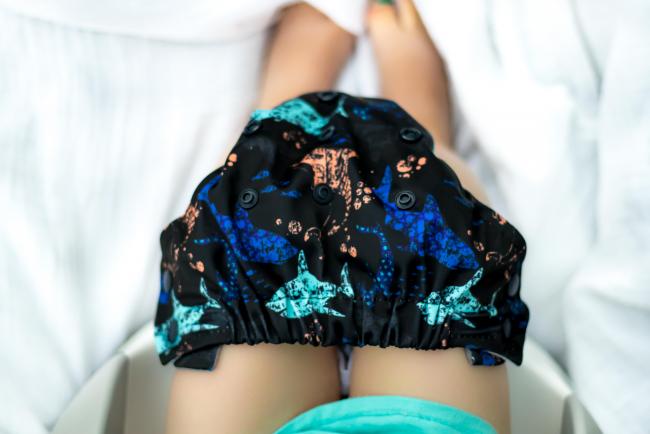
Child on the potty, wearing Buttons training pants. In case of an accident, do not change the bed, but only put on clean pants!
What if staying dry for a long time at night isn't happening?
-Check whether your child suffers from constipation. With full intestines there is less room for a full bladder.
-Do not let your child drink too much just before bedtime.
-Make sure your child drinks enough during the day. Children who drink very little during the day often have a relatively small bladder and therefore cannot retain enough urine at night.
-Avoid (especially towards bedtime) carbonated drinks and caffeinated drinks (tea, chocolate, cola, energy drinks). These can irritate the bladder.
-Rule out a medical problem, such as a bladder infection. If your child previously stayed dry at night and now does not, consider visiting your doctor, especially if you cannot identify the cause yourself.
-During stressful periods, a child can also relapse and start wetting the bed again. Stay calm, get a child out of bed in the evening if necessary and continue to reward when things are going well.
Always keep in mind that in most cases, night toilet training really comes naturally and should come naturally. There is very little to 'train'. It may simply be too early for your child. Especially when a child gets a little older and really wants to go without a diaper, it can be extremely frustrating and sad. It can help to tell your child that many other children also wet the bed at night, or perhaps that you as a mom or dad have also wet the bed for a long time in the past. Give your child the feeling that it is not a big deal, that it is normal and that everything will turn out fine.
In some cases it can give you peace of mind to go back to a diaper for a while. There is also a range of diapers that are suitable for use at night for older children and teenagers.
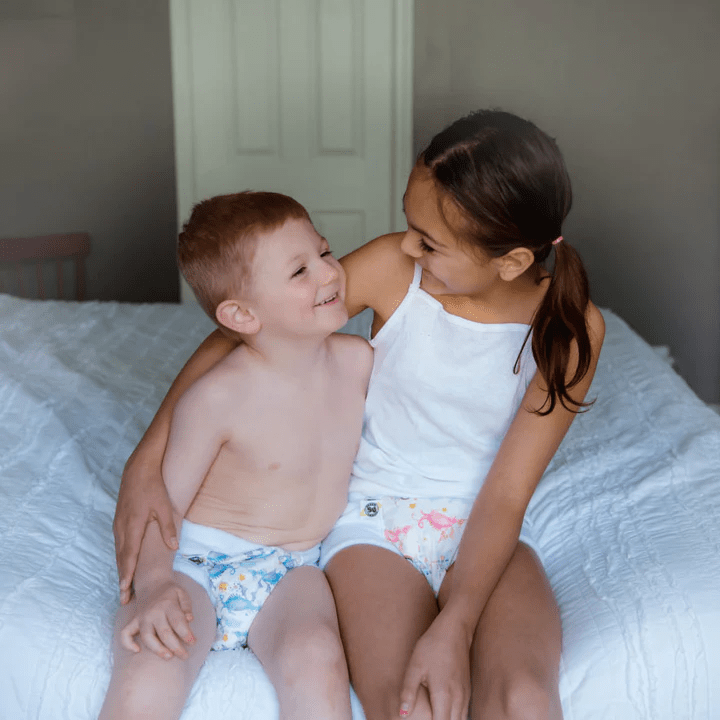
Even at an older age, bedwetting still occurs frequently, fortunately bedwetting almost always goes away on its own.
When should you seek help for bedwetting?
In most Western countries, bedwetting is only treated by a doctor from the age of about 7, and in fact only if a child is bothered by it and wants to get rid of it. If you want help for your child, you can arrange this through your general practitioner. Although bedwetting rarely has a physical cause, this is often ruled out first. Bladder instability, backflow of urine into the urinary tract and to the kidneys and extra tissue in the urinary tract are often examined. If physical problems have been ruled out, the bedwetting alarm mentioned earlier can be used, or medication can be started based on the hormone vasopressin. Both solutions have a success rate of 50-70%.
Starting with night toilet training
Just like with day toilet training, there is no perfect time to start. Provide a moment of peace in your child's life to increase the chance of success. If it is not successful after a few weeks, it is probably still too early for your child. Then try again a few months later. Ultimately, that moment of night-time toilet trained comes naturally in almost all cases. And if not, consult a doctor, but know that there are suitable reusable products for children and adults of all ages to deal with (temporary) incontinence. The figures and advice described in this blog are based on healthy children without physical or intellectual disabilities. If you are looking for incontinence aids for your child, for the day or at night, do not hesitate to ask us for help.
Written by Ilka, owner Nappy's.nl
